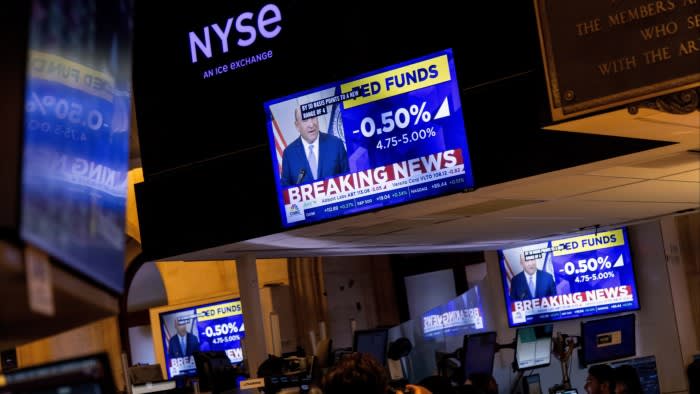Unlock the Editor’s Digest for free
Roula Khalaf, Editor of the FT, selects her favourite stories in this weekly newsletter.
Jay Powell, chair of the Federal Reserve, scored a big win this week when the US central bank started its rate-cutting cycle with a bang, chopping half a percentage point off the benchmark.
Typically, that is a distress signal to markets — a flag that the economy is in dire shape or that the central bank knows it is cutting too late. Powell however convinced investors this was a luxury decision. It cut rates hard because it can. This deft piece of central banker speak succeeded in not spooking the horses; stocks and bonds very much held their cool.
Now the common assumption is that the rate cut — the start of a long series, judging from the Fed’s messaging — will prompt a huge wave of cash being held by investors to spill on to the shores of risky markets. Any day now this will start landing. Just you wait. It sounds too good to be true, and probably is.
In “cash”, we are not so much talking about polymer notes and metal coins, and not even so much these days about bank deposits, which pay out vanishingly tiny rates in the US. Instead, the focus among investors is on short-term deposits — money market funds and the like — carrying interest rates closely mirroring benchmark central bank rates.
Asset managers have been saying for months that the game is up for cash, which had its latest heyday in the inflationary outburst of 2022, offering a haven while stocks and bonds bled out. This year and last, sensible people have repeatedly told me it made no sense to hold on in the immediate run-up to the rate-cutting cycle. When cash piles kept building up anyway, they said the outflows will start when rates start to fall. All that cash sitting on the sidelines is about to be unleashed. Again, any day now. Well, now the day is here so we will see if they are right.
It is hard to ignore the size of this asset class. Added together, money market funds hold easily north of $6tn in the US, up by 15 per cent since the start of last year and with a pronounced pick-up just before this week’s rate cut.
Gene Tannuzzo, global head of fixed income at Columbia Threadneedle, has dubbed this fondness for cash as “T-bill and chill”. (T-bills are Treasury bills, or US government debt instruments with a maturity under a year, and finance jokes are generally bad, what can I say?) Now, he says, “cash is cool, but bonds are better”.
The problem, for fund managers in riskier or longer-term asset classes salivating at the notion of catching some of this cash on its way out, is that a “T-bill and chill” strategy still dishes out roughly 4.5 per cent in the US. Investors say this forms a high hurdle when trying to lure clients away. Ten-year US government bonds still yield well under 4 per cent. And if we do get an ugly global recession, even with sliding interest rates, investors tend to huddle in the safety of cash. To many, it still feels like a nice warm easy-access comfort blanket.
Deborah Cunningham, chief investment officer for global liquidity markets at Federated Hermes, said at a presentation this week that she still expects money to flow in to cash, partly because the impact of rate cuts takes a little while to trickle through. She still expects assets in this area to reach $7tn. Investors don’t tend to balk at the rate available on cash until it sinks to 1 per cent or below — an unlikely scenario in this more inflationary world after the pandemic, or at least a scenario she hopes never to see again in her lifetime, she said.
“Contrary to what many others are currently saying which suggests a mass exodus of cash from money market funds during falling rates, historical data shows us otherwise,” she said. Set in contrast to US bank deposit rates, which can often be under 1 per cent, “rates can be 3 per cent and money market funds still look attractive”, she added.
It does still seem reasonable to assume that money will leak out of cash and in to higher yielding assets as benchmark rates come down, eventually at least. But where will it go? Equity fund managers say it is heading to equities, government bond fund managers say government bonds, and credit fund managers, surprisingly enough, say credit. The latter group there may have the strongest case — their asset class delivers just a little bit more yield than government bonds, less drama than stocks, and, for the safest companies at least, a very low risk of default.
In the mean time, the stickiness of cash is a source of irritation. “There has been such strong demand for cash products,” said Joop Kohler, head of credit at Dutch asset manager Robeco. “I totally get that, but it’s also a frustration that we don’t see $800bn heading back to the credit market. Momentum is shifting but we would like to see it faster.”
Professional investors looking longingly at the huge accumulation of funds in boring old cash should remember that $6tn sounds like a lot of money. It is a lot of money. But it is still less than the market capitalisation of two Apples. Possibly the most likely outcome is that the much-vaunted wave of cash will turn out to be a slow trickle that spreads widely across riskier asset classes without making much of a splash.
katie.martin@ft.com
https://www.ft.com/content/be8f5040-9fac-4ab2-aba8-10de10e90ca6


